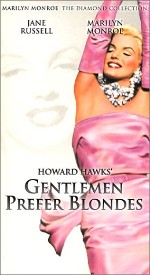 Mention diamonds and celebrity in the same sentence and many people have the mental image of Marilyn Monroe singing “Diamonds are a Girl’s Best Friend” in the 1954 movie “Gentleman Prefer Blondes.”
Mention diamonds and celebrity in the same sentence and many people have the mental image of Marilyn Monroe singing “Diamonds are a Girl’s Best Friend” in the 1954 movie “Gentleman Prefer Blondes.”
Like many top Hollywood stars of her time, Marilyn was able to wear beautiful diamonds on loan from jewelers at public appearances and promotions. At a promotion for the move “Gentleman Prefer Blondes” Marilyn Monroe wore The Moon of Baroda, a 24.04 carat, pear shaped yellow diamond worn by Marie Antoinette in the 18th century.
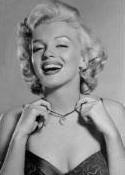 This diamond weighed 25.95 carats before being recut to its current weight. The Moon of Baroka diamond originally came from India, was looted by Afghan tribal leader Nadir Shah in 1739, later returned to Baroda (in western India) where it was kept for almost 200 years until 1943 when it was purchased by Meyer Rosenbaum of Detroit. In 1991 the diamond was auctioned by Christie’s, New York. Marilyn Monroe’s brief promotional shoot in 1954 simply added to the colorful history of the Moon of Baroka.
This diamond weighed 25.95 carats before being recut to its current weight. The Moon of Baroka diamond originally came from India, was looted by Afghan tribal leader Nadir Shah in 1739, later returned to Baroda (in western India) where it was kept for almost 200 years until 1943 when it was purchased by Meyer Rosenbaum of Detroit. In 1991 the diamond was auctioned by Christie’s, New York. Marilyn Monroe’s brief promotional shoot in 1954 simply added to the colorful history of the Moon of Baroka.
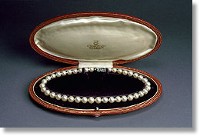 De Beers knew that diamonds on celebrities was one of the sure ways to generate demand for the sparkling gems. It worked in Marilyn’s day and it works today as witnessed by the bling at red carpet events.
De Beers knew that diamonds on celebrities was one of the sure ways to generate demand for the sparkling gems. It worked in Marilyn’s day and it works today as witnessed by the bling at red carpet events.
Ironically, Marilyn personally owned mostly costume jewelry. Her fine jewelry consisted of only two valuable pieces, an eternity diamond ring and a strand of pearls, both gifts from her husband Joe DiMaggio.
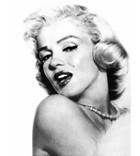 Joe DiMaggio bought his bride, Marilyn Monroe, a classic cultured Akoya pearl necklace during their honeymoon in Japan in 1954. Marilyn Monroe gave the sixteen inch strand of pearls containing forty-four Mikimoto pearls to friend Paula Strasberg, and her daughter Susan Strasberg returned the necklace to Mikimoto in 1998. The pearls have been displayed in numerous exhibits where part of their attraction is that the pearls are displayed in their original oval box. It does not take much imagination to envision Joe presenting the box to Marilyn.
Joe DiMaggio bought his bride, Marilyn Monroe, a classic cultured Akoya pearl necklace during their honeymoon in Japan in 1954. Marilyn Monroe gave the sixteen inch strand of pearls containing forty-four Mikimoto pearls to friend Paula Strasberg, and her daughter Susan Strasberg returned the necklace to Mikimoto in 1998. The pearls have been displayed in numerous exhibits where part of their attraction is that the pearls are displayed in their original oval box. It does not take much imagination to envision Joe presenting the box to Marilyn.
 Marilyn and the late baseball great Joe DiMaggio were married for nine months in 1954. The diamond and platinum “eternity” wedding band held thirty-five baguette cut diamonds. In 1999, the eternity ring (less one lost diamond) sold for $772,500. Auction house Christie’s pre-sale estimates of the ring’s likely selling price ranged from $30,000 to $50,000 but the sentimental power of Marilyn Monroe produced a 15 times greater value.
Marilyn and the late baseball great Joe DiMaggio were married for nine months in 1954. The diamond and platinum “eternity” wedding band held thirty-five baguette cut diamonds. In 1999, the eternity ring (less one lost diamond) sold for $772,500. Auction house Christie’s pre-sale estimates of the ring’s likely selling price ranged from $30,000 to $50,000 but the sentimental power of Marilyn Monroe produced a 15 times greater value.
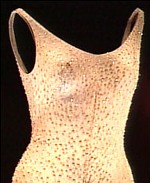 Diamonds may be a girl’s best friend, but it was a white gown made by French designer Jean Louis, covered with 6,000 rhinestone beads and sequins that sold for $1,267,500, to a New York collectibles store owner, and brought the top dollar at the auction of Marilyn’s personal items.
Diamonds may be a girl’s best friend, but it was a white gown made by French designer Jean Louis, covered with 6,000 rhinestone beads and sequins that sold for $1,267,500, to a New York collectibles store owner, and brought the top dollar at the auction of Marilyn’s personal items.
The full length evening sheath dress of flesh colored souffle gauze was made famous when Marilyn Monroe wore it the night in 1962 when she sang “Happy Birthday, Mr. President” to John F. Kennedy in Madison Square Garden.
Peter Lawford was making fun of Marilyn’s perpetual lateness by giving her a really long introduction, during which she should have come on-stage several times. In the middle of his last attempt, she sauntered on-stage. He introduced her as “the late Marilyn Monroe.”
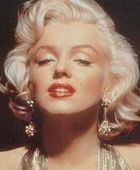 After Marilyn’s seductive “Happy Birthday, Mr. President,” JFK thanked Marilyn by saying “I can now retire from politics after having had Happy Birthday sung to me in such a sweet, wholesome way.”
After Marilyn’s seductive “Happy Birthday, Mr. President,” JFK thanked Marilyn by saying “I can now retire from politics after having had Happy Birthday sung to me in such a sweet, wholesome way.”
Marilyn Monroe, born Norma Jean Mortenson in 1926, died August 5, 1962. She left her personal belongings to her acting coach and mentor, Lee Strasberg, who died twenty years later. The Strasberg family kept Marilyn’s items archived for almost 40 years before they were auctioned at Rockefeller Center in 1999.
